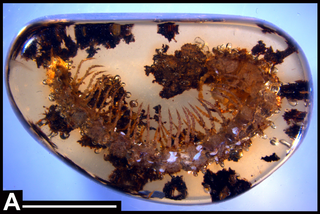 W
WAnbarrhacus is an extinct genus of millipede in the family Platyrhacidae known from a fossil found in North America. There is one described species in the genus, Anbarrhacus adamantis, which is one of three millipedes described from Mexican amber.
 W
WArchidesmus is an extinct millipede genus from the Lower Devonian Old Red Sandstone of the United Kingdom. It is the only member of the taxonomic family Archidesmidae. Individuals were up to 5 cm (2.0 in) long, and had 60 to 80 body segments decorated with tubercles (bumps) on the upper surface, and most segments possessed wing-like keels (paranota) extending to the side. The type species Archidesmus macnicoli was described by British paleontologist Benjamin Peach in 1882. A second species, A. loganensis was also described by Peach but its status as a valid species- or even a myriapod- is debated.
 W
WMyriacantherpestes is an extinct genus of spiny millipedes from the Pennsylvanian subperiod of the Carboniferous period, known from fossils in Europe and North America.
 W
WPalaeosoma is an extinct genus of archipolypodan millipedes from the upper Carboniferous of England and Poland. Individuals grew to nearly 20 cm (7.9 in) long and possessed defensive glands (ozopores) located on small raised nodes on the outer edges of the upper surface of each body segment. Species of Palaeosoma were once considered members of the family Euphoberiidae, which contains species with prominent spines, but are now classified in their own family (Paleosomatidae) and own order (Palaeosomatida), as they lack spines and have a combination of features not seen in other Paleozoic millipedes.
 W
WPneumodesmus newmani is a species of myriapod that lived in the Paleozoic. Its exact age is uncertain; it was originally interpreted as living 428 million years ago, in the Late Silurian; however, subsequent research dates it to around 414 million years old, in the Early Devonian (Lochkovian). It is one of the first myriapods, and among the oldest creatures to have lived on land It was discovered in 2004, and is known from a single specimen from Stonehaven, Aberdeenshire, Scotland.
 W
WAmynilyspes is an extinct genus of pill millipedes characterized by fourteen tergites, large eyes, and prominent spines. Individuals measure up to 30 mm (1.2 in) in length.
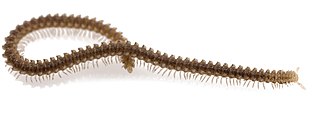 W
WAndrognathus is a genus of North American millipedes in the family Andrognathidae, containing three species: A. corticarius, A. grubbsi, and A. hoffmani. The fossil species Andrognathus burmiticus is known from approximately 99 million year old Burmese amber from Myanmar, showing that the genus had a much wider distribution in the past.
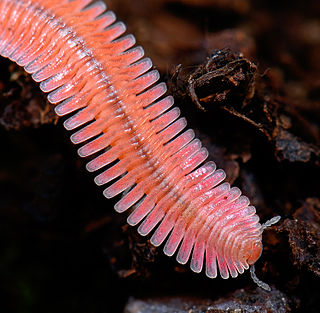 W
WBrachycybe (Greek for "short head") is a genus of andrognathid millipedes with species in the United States and East Asia. In a rare example of paternal care in invertebrates, males of most species guard the eggs until they hatch.
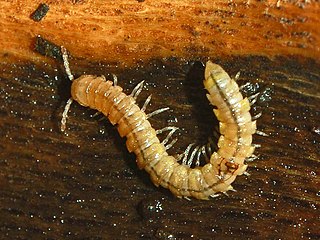 W
WBrachydesmus is a genus of millipedes belonging to the family Polydesmidae.
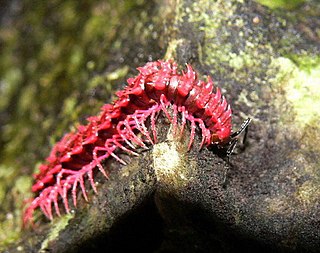 W
WDesmoxytes, whose species are commonly known as the dragon millipedes, is a genus of millipedes of the family Paradoxosomatidae found in Southeast Asia. The genus was described by Ralph Vary Chamberlin in 1923, and reviewed by Sergei Golovatch and Henrik Enghoff in 1994. At least 18 species are known from to Malaysia, Myanmar, and Thailand. One species, D. planata, has also been observed in Sri Lanka, the Andaman Islands, Seychelles, Java, Great Coco Island, and Fiji; however, this species has expanded its range by being transported through human activity. Several species have only recently been discovered, and some have yet to be officially described.
 W
WDoratogonus is a genus of millipedes in family Spirostreptidae. They are relatively large, at 80–200 millimetres (3–8 in) long, relatively common, and distributed across Southern Africa. Many of the species are listed on the IUCN Red List due to habitat destruction.
 W
WIllacme is a genus of millipedes in the family Siphonorhinidae. It includes two species. Illacme plenipes was first described in 1928 from San Benito County, California, and rediscovered in 2005. In 2016, Illacme tobini was described based on a single male specimen collected in 2006 from Lange Cave, in Sequoia National Park, 240 km (150 mi) east of the known habitat for I. plenipes.
 W
WLophoturus is a genus of millipedes belonging to the family Lophoproctidae. Species described after year 2000 include two from Queensland, Australia, three from Christmas Island, Australia, and three from the Caribbean and northern South America.
 W
WMaatidesmus is an extinct genus of millipede in the family Chelodesmidae known from a fossil found in North America. There is one described species in the genus, Maatidesmus paachtun, one of three millipedes described from Mexican amber.
 W
WMegaphyllum is a genus of myriapods belonging to the family Julidae.
 W
WOrthomorpha is a genus of millipedes in the family Paradoxosomatidae containing approximately 50 species distributed in Southeast Asia.
 W
WProcyliosoma is a genus of pill millipede found in Australia and New Zealand. Formerly classified in the family Sphaerotheriidae, in 2009 Procyliosoma was reclassified as the only genus in the family Procyliosomatidae.
 W
WSinocallipus is a genus of predominantly cave-dwelling millipedes in the order Callipodida. Five of the six known species are found in limestone caves on the Indochinese Peninsula from Vietnam to southern China, and it is the only callipodidan genus entirely confined to the tropics. Individuals range from 40–70 mm (1.6–2.8 in) long and possess 55 to 70 segments. Sinocallipus is the sole taxon of the callipodidan suborder Sinocallipodidea, and thought to be the most primitive and sister group to all other callipodidans. In contrast to many other millipede groups, the gonopods of Sinocallipus show little variation between species, while other characters such as color, size, and other body parts differ more noticeably between species.
 W
WSiphoniulus is a poorly known genus of millipede containing only two living species: S. alba from Indonesia, and S. neotropicus from Mexico and Guatemala. An additional two fossil species are known from Cretaceous amber. Siphoniulus species are the only members of the family Siphoniulidae and order Siphoniulida, making Siphoniulida the smallest millipede order. Few specimens are known, and their classification is contentious, although most recent studies place them as basal members of the Helminthomorpha.
 W
WSphaeromimus, or the chirping giant pill millipedes, is a genus of giant pill millipedes endemic to southeastern Madagascar. Though described in 1902, the genus was up to 2005 known from a single male specimen, whose appearance was so unusual that the authors suspected a mislabeled giant pill-millipede from India. Their unusual and distinct morphology includes well-developed stridulation organs, probably as devices for courtship. These are the male ‘harp’ and the female ‘washboard’, which contain more stridulation ribs than in other members of the order Sphaerotheriida. They have a closer affinity with the Indian genus Arthrosphaera than to other Malagasy genera, though all belong to the Arthrosphaeridae.
 W
WTachypodoiulus is a genus of millipedes in the family Julidae which contains three species.
 W
WUnciger is a genus of millipedes belonging to the family Julidae.
 W
WXenobolus is a genus of millipedes in the family Pachybolidae, containing two species found in India and Sri Lanka. The species are unusual within the Pachybolidae in being boldly colored with red bands or spots on a blackish background color.
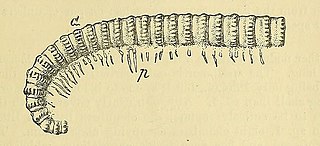 W
WXyloiulus is an extinct genus of millipede that lived during the Late Carboniferous which grew up to 2.25 inches (5.7 cm) in length. Fossils of the animal have been found in North America and Europe. The fossils are typically found in Sigillarian stumps.